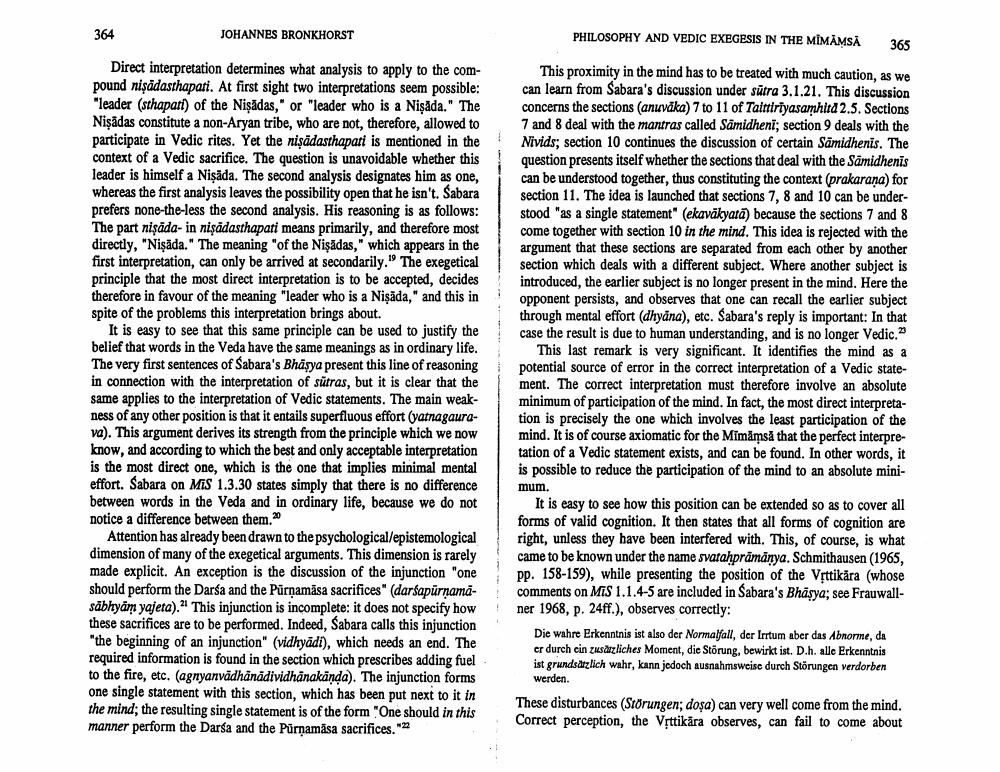________________
364
JOHANNES BRONKHORST
Direct interpretation determines what analysis to apply to the compound nişädasthapati. At first sight two interpretations seem possible: "leader (sthapati) of the Nisadas," or "leader who is a Nişăda." The Nişādas constitute a non-Aryan tribe, who are not, therefore, allowed to participate in Vedic rites. Yet the nişädasthapati is mentioned in the context of a Vedic sacrifice. The question is unavoidable whether this leader is himself a Nișăda. The second analysis designates him as one, whereas the first analysis leaves the possibility open that he isn't. Sabara prefers none-the-less the second analysis. His reasoning is as follows: The part nişāda- in nişādasthapati means primarily, and therefore most directly, "Nişāda." The meaning "of the Nisadas," which appears in the first interpretation, can only be arrived at secondarily." The exegetical principle that the most direct interpretation is to be accepted, decides therefore in favour of the meaning "leader who is a Niṣāda," and this in spite of the problems this interpretation brings about.
It is easy to see that this same principle can be used to justify the belief that words in the Veda have the same meanings as in ordinary life. The very first sentences of Sabara's Bhasya present this line of reasoning in connection with the interpretation of sutras, but it is clear that the same applies to the interpretation of Vedic statements. The main weakness of any other position is that it entails superfluous effort (yatnagaurava). This argument derives its strength from the principle which we now know, and according to which the best and only acceptable interpretation is the most direct one, which is the one that implies minimal mental effort. Sabara on MIS 1.3.30 states simply that there is no difference between words in the Veda and in ordinary life, because we do not notice a difference between them."
Attention has already been drawn to the psychological/epistemological dimension of many of the exegetical arguments. This dimension is rarely made explicit. An exception is the discussion of the injunction "one should perform the Darsa and the Pürṇamāsa sacrifices" (darsapurṇamāsabhyam yajeta)." This injunction is incomplete: it does not specify how these sacrifices are to be performed. Indeed, Sabara calls this injunction "the beginning of an injunction" (vidhyādi), which needs an end. The required information is found in the section which prescribes adding fuel to the fire, etc. (agnyanvädhänādividhänakända). The injunction forms one single statement with this section, which has been put next to it in the mind; the resulting single statement is of the form "One should in this manner perform the Darsa and the Pürṇamāsa sacrifices."22
PHILOSOPHY AND VEDIC EXEGESIS IN THE MIMAMSA 365
This proximity in the mind has to be treated with much caution, as we can learn from Sabara's discussion under sutra 3.1.21. This discussion concerns the sections (anuvaka) 7 to 11 of Taittiriyasamhita 2.5. Sections 7 and 8 deal with the mantras called Samidheni; section 9 deals with the Nivids; section 10 continues the discussion of certain Samidhenis. The question presents itself whether the sections that deal with the Samidhenis can be understood together, thus constituting the context (prakarana) for section 11. The idea is launched that sections 7, 8 and 10 can be understood "as a single statement" (ekaväkyata) because the sections 7 and 8 come together with section 10 in the mind. This idea is rejected with the argument that these sections are separated from each other by another section which deals with a different subject. Where another subject is introduced, the earlier subject is no longer present in the mind. Here the opponent persists, and observes that one can recall the earlier subject through mental effort (dhyana), etc. Sabara's reply is important: In that case the result is due to human understanding, and is no longer Vedic."
This last remark is very significant. It identifies the mind as a potential source of error in the correct interpretation of a Vedic statement. The correct interpretation must therefore involve an absolute minimum of participation of the mind. In fact, the most direct interpretation is precisely the one which involves the least participation of the mind. It is of course axiomatic for the Mimämsă that the perfect interpretation of a Vedic statement exists, and can be found. In other words, it is possible to reduce the participation of the mind to an absolute minimum.
It is easy to see how this position can be extended so as to cover all forms of valid cognition. It then states that all forms of cognition are right, unless they have been interfered with. This, of course, is what came to be known under the name svatahprämanya. Schmithausen (1965, pp. 158-159), while presenting the position of the Vṛttikära (whose comments on MIS 1.1.4-5 are included in Sabara's Bhasya; see Frauwallner 1968, p. 24ff.), observes correctly:
Die wahre Erkenntnis ist also der Normalfall, der Irrtum aber das Abnorme, da er durch ein zusätzliches Moment, die Störung, bewirkt ist. D.h. alle Erkenntnis ist grundsätzlich wahr, kann jedoch ausnahmsweise durch Störungen verdorben werden.
These disturbances (Störungen; doşa) can very well come from the mind. Correct perception, the Vṛttikära observes, can fail to come about




